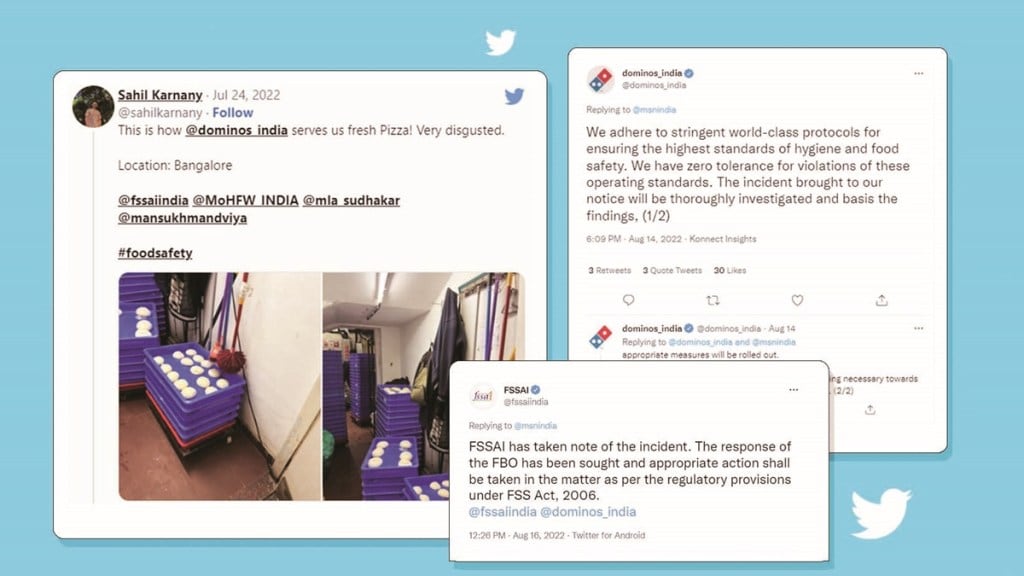Food delivery giant Domino’s is under the scanner for alleged unhygienic storage practices. While the company has been quick to reassure consumers via Twitter that it had “zero tolerance for violations of high safety standards”, three brand experts tell Akanksha Nagar how companies can formulate robust strategies for trouble-shooting in a highly connected world.
‘Turn complainants into brand advocates’
Alagu Balaraman, CEO, Augmented SCM
The social media crisis of Domino’s was not just a social media fiasco, it was a revelation of the company’s quality assurance programme. The food industry is very sensitive to both actual quality assurance as well as perceived quality assurance. Assuring customers on quality requires processes, verification, action and reporting. For example, in one food company, a customer complaint was followed up by having someone visit the customer at home, collecting available evidence, a follow-up call explaining what action was taken and a gift hamper given as an apology. Also, if there was a manufacturing fault traced back to a factory, there were implications for everyone working there. This ensured that the seriousness of the case was understood throughout the organisation and by customers.
Actions do speak louder than words, but it’s important to get the words right. It is critical that quick and specific communication is sent to the original complainant. This is best worked out in scenarios in advance, to avoid poorly thought-out messaging at a time of crisis. Acting and communicating quickly, honestly and transparently about the consumers’ concerns, builds on the brand’s commitment within the company and often makes complainants brand advocates rather than critics.
‘Pre-emptive crisis plan minimises damage’
Shradha Agarwal, Co-founder and CEO, Grapes
Considering that disasters happen without any prior warning, a pre-emptive crisis management strategy can help in coming out of the situation with minimal damage. It enables companies to take control of the narrative and address the crisis instantly. It is the only way to reduce misinformation and gives the much-needed space to brands to share perspectives on their terms. In its absence, firms can find themselves caught in an unending spiral where they just look for excuses to fend off the criticism or play a defensive game.
In such crises times, brands need to lead the conversation and set the tone right. Classifying the crisis is the very first step. There are instances where the situation is not intense, like the chicken shortage in KFC where it issued a light-hearted apology to tackle it. On the other hand, we can take the instance of the Domino’s crisis where some serious allegations have been made.
In such a crisis, companies must take cohesive steps — such as coming forward and taking responsibility. Assurance must be given to the audience that their interest and well-being will always be protected and strict action will be taken after investigation. Finally, select a proficient spokesperson, who has thorough knowledge of the situation and who can interact with people.
‘There’s no alternative to speedy intervention’
Ramesh Narayan, Founder, Canco Advertising
Every company would like to believe that it will face clear blue skies and gentle tailwinds. Yet, every company, regardless of the kind of business it is in, or the range of products or services it deals with, could face stormy seas and gale-force winds at some time or the other.
The first step would be to assess all the possible crisis points and work toward ensuring they do not reach the stage of a crisis. But sometimes, despite the best efforts, brands end up staring at a crisis. It is essential to plan ahead, anticipate what could go wrong, and plan out a carefully thought-out strategy to be able to look the crisis in the eye and take immediate steps to mitigate the possible adverse effects it could bring with it.
Today’s consumer is empowered by technology (to be read as social media) and every person has access to a megaphone in the digital world, and many times, this is amplified by a group of willing sympathisers. Speed is of the essence. And while thinking on one’s feet is something we all may need to do, a carefully rehearsed plan of action could enhance the comeback manifold.
A good manager executes even crisis management activity to a pre-emptive plan. In that lies the opportunity to ensure that there is a sense of calm in the midst of the storm.
Also Read: Ad volumes on radio grew by 62% in H1,2022 over H1,2021: TAM AdEx


